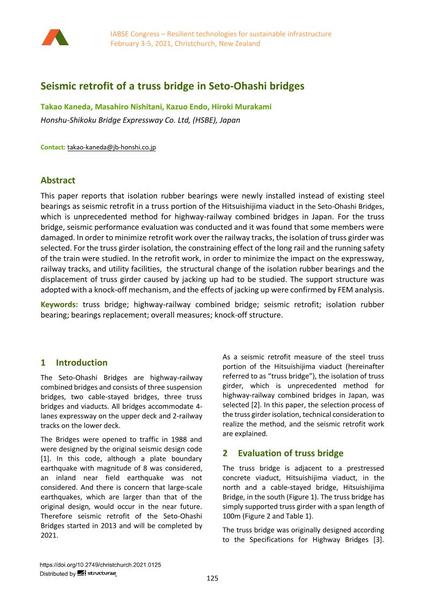Seismic retrofit of a truss bridge in Seto-Ohashi bridges

|
|
|||||||||||
Détails bibliographiques
| Auteur(s): |
Takao Kaneda
(Honshu-Shikoku Bridge Expressway Co. Ltd, (HSBE), Japan)
Masahiro Nishitani (Honshu-Shikoku Bridge Expressway Co. Ltd, (HSBE), Japan) Kazuo Endo (Honshu-Shikoku Bridge Expressway Co. Ltd, (HSBE), Japan) Hiroki Murakami (Honshu-Shikoku Bridge Expressway Co. Ltd, (HSBE), Japan) |
||||
|---|---|---|---|---|---|
| Médium: | papier de conférence | ||||
| Langue(s): | anglais | ||||
| Conférence: | IABSE Congress: Resilient technologies for sustainable infrastructure, Christchurch, New Zealand, 3-5 February 2021 | ||||
| Publié dans: | IABSE Congress Christchurch 2020 | ||||
|
|||||
| Page(s): | 125-132 | ||||
| Nombre total de pages (du PDF): | 8 | ||||
| DOI: | 10.2749/christchurch.2021.0125 | ||||
| Abstrait: |
This paper reports that isolation rubber bearings were newly installed instead of existing steel bearings as seismic retrofit in a truss portion of the Hitsuishijima viaduct in the Seto-Ohashi Bridges, which is unprecedented method for highway-railway combined bridges in Japan. For the truss bridge, seismic performance evaluation was conducted and it was found that some members were damaged. In order to minimize retrofit work over the railway tracks, the isolation of truss girder was selected. For the truss girder isolation, the constraining effect of the long rail and the running safety of the train were studied. In the retrofit work, in order to minimize the impact on the expressway, railway tracks, and utility facilities, the structural change of the isolation rubber bearings and the displacement of truss girder caused by jacking up had to be studied. The support structure was adopted with a knock-off mechanism, and the effects of jacking up were confirmed by FEM analysis. |
||||
| Mots-clé: |
pont en poutre en trellis reconception pour effets sismiques
|
||||
